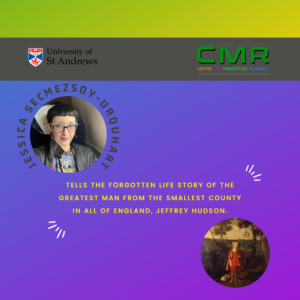In this episode, listen to St. Andrews History PhD student, Jessica Secmezsoy-Urquhart, as they tell the forgotten life story of the Greatest Man from the Smallest County in all of England, Jeffrey Hudson. As a young boy of only 1 1/2 foot tall, at the age of 7 his life changed forever when Charles I friend, the Duke of Buckingham, had him become his household dwarf before showing him at a royal banquet, which saw him given a new position as court dwarf and wonder (someone celebrated for looking physically different but not considered a monster) in Queen Henrietta Maria’s royal household. What followed was a life of great privilege but also great sorrow, as Hudson found himself over his life defined as everything from court dwarf, entertainer, warrior, Civil War Captain of Horse, Ottoman slave, Catholic Prisoner, Elderly Pauper to Murderer.
Podcast references:
Yi-Fu Tuan, Dominance and Affection: The Making Of Pets(New Haven: Yale University Press, 1984), pp. 1-2, 153, 160
Norah Dunbar and Judee Burgoon, Perceptions of power and interactional dominance, p. 207-210
Lorraine Daston and Katharine Park, Wonders and the Order of Nature
Touba Ghadessi, Inventoried Monsters, p. 271
Thomas Aquinas , Treatise on Human Nature: The Complete Text (Summa Theologiae I, Questions 75-102), trans. Alfred Freddoso(France: St. Augustine Press, 2010),bk.1 ,q.96, art.2 ,p.742
Susan Stewart, On Longing, Narratives of the Miniature, the Gigantic, The Souvenir, the Collection (Baltimore, 1984), pp. 65,69,70-71,111
Charles Thompson, The Mystery and Lore of Monsters (New York, 1931), p. 142.
Touba Ghadessi, ‘Inventoried Monsters: Dwarves and Hirsutes at Court’, Journal of the History of Collections, 23 (2010), pp. 267-281, p. 271
Robin O’Bryan, ‘Grotesque Bodies, Princely Delight: Dwarfs in Italian Renaissance Court Imagery’, Preternature,1, 2 (2012), pp. 252-288, pp. 257-260;
John Southworth, Fools and Jesters at The English Court (Stroud, 1998, p. 16;
Megan G. Leitch, ‘The Servants of Chivalry? Dwarves and Porters in Malory and the Middle English Gawain Romances’, Arthuriana, 27, 1 (SPRING, 2017), pp. 3-27, pp. 3-8, 10-11
Alan Bates, Emblematic Monsters (Amsterdam, 2005), p.15
Lorraine Daston and Katharine Park, Wonders and the Order of Nature (New York, 1998), pp. 175, 192-193.
Deanna Shemek (ed. And trans), Selected Letters of Isabella d’Este (Toronto, 2016), p. 204.

